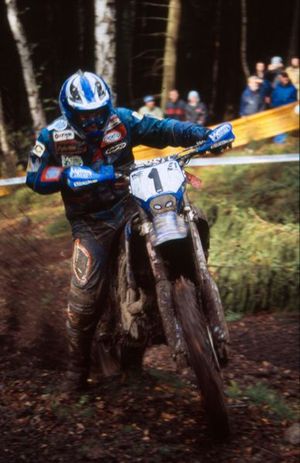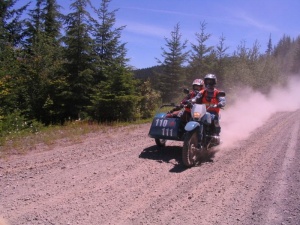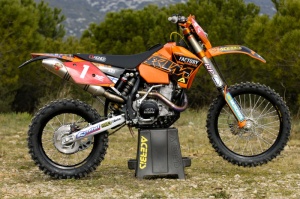Enduro
| ENDURO EXTREME TEST |
|---|
Enduro is a form of motorcycle sport run on courses that are predominantly off-road. The main type of enduro event, and the format to which the world enduro championship is run, is a time-card enduro, whereby a number of stages are raced in a time trial against the clock.
Time-Keeping Enduros
Although the term Enduro often applies to any type of long-distance, off-road motorcycle races, its true technical definition usually refers to a set of rules, varying by the events' governing body, that specify exactly when a rider should arrive at certain pre-defined locations along a prescribed route. The object of the event is to arrive at those locations exactly per the defined schedule, with early or late arrivals resulting in penalties to the riders' scores. This sort of event is not technically a Race, but rather it is a Time Keeping event.
In a true Enduro timekeeping event, riders leave together in groups called, in the USA, "rows," and each row starts on a certain minute. For example, if in a particular Enduro the first row leaves at 8AM, and a certain rider's row is scheduled to leave at 08:20, then the event's Key Time is 08:00 and every rider on Row 20 (usually 4 riders per row) has as his/her minute 20, because his/her start time will be 08:20. To be "on his/her minute," a rider must arrive at certain non-disclosed locations known as checkpoints along the route at the prescribed time, which is the prescribed time for Row 1 plus 20 minutes. There are different types of checkpoints, such as known checks, secret checks, emergency checks, start checks, and finish checks, and points are calculated differently depending on how late or early a rider arrives at each type of check. For example, emergency checks are used to break scoring ties and points are calculated depending on the number of seconds that a rider is early or late, whereas in a standard secret check, points are calculated based on the number of minutes that a rider is early or late. There are also, in UK enduros, 'Special-Tests' which are sections, which may be walked-only, not ridden, before the event where, during the event, the distance between the 'test-start' and 'test-finish' must be covered as quickly as possible. Electronic timing is used to separate riders times by thousandths of a second to determine a result in the case of a tie. This is the part of the course that often attracts most spectators. Other spectator points are usually 'bog-holes' or awkward and difficult stream and river crossings out on the 'open' part of the course.
There are very specific rules governing where race-sponsors may place checks, and what types. The rules usually refer to a distance from previous checks, or minimum distances for certain stops such as fuel stops. The careful placement of checks to confuse riders is part of the appeal to Enduro enthusiasts. A good Enduro rider is as familiar with the rules and possibilities as the race organizers, and therefore can predict where checks may or may not be, and rides accordingly to ensure that he/she arrives at the next check as close to his scheduled minute as possible.
Riders in the USA use "Roll Charts" (which are provided by the race organizers) to guide them along the course. A roll chart is a small paper scroll (2-3 inches, 10-15cm wide) that has all of the turns and known checkpoints listed. As the rider traverses the route, he/she advances his roll chart in sequence with the mileage listed on the odometer, and uses the markings on the chart and the trail to both navigate the course and to "stay on his minute." Not all checks are on the roll-chart, though. For example Secret Checkpoints are those which help to create scoring differentiation between riders by adding unpredictability to the route. They are called "secret" because they are unknown to the riders until they come upon them, as they don't exist on the roll-chart.
In recent years, Enduro Computers have become popular with some riders. Enduro Computers are small instruments that are attached to the bike's handlebars and that have a sensor/sender/magnet combination that calculates revolutions of the front wheel and sends the data to the computer. Once the roll-chart data have been entered, the Enduro Computer tells the rider a variety of information to remove the guesswork from roll-chart reading. Enduro Computers come pre-programmed with the Enduro rules (depending on which rules are being used), and once programmed with the roll-chart of a particular event, can tell the rider when to expect an upcoming unknown check, speed averages, how much faster or slower he/she must ride to "get back on his/her minute," distance travelled, speed, etc... Using an Enduro Computer removes the guesswork from Enduro riding, and by using one, the mental part of the Enduro competition is greatly reduced. Many people have likened Enduro Computers to cheating, while others consider them to be boons to the sport. Either way, using an Enduro Computer absolves the rider from having to learn the specifics of the rules, all of the possible circumstances that could be encountered during a race, etc... Some people consider that to be a bad thing, and most top riders use both a standard roll chart (which they know how to use very well) and an Enduro Computer, just in case the computer somehow breaks during an event. In Britain, the 'long-distance' enduros, whilst declining, are still run to the form of time-card events.
Throughout a day there will also be allocated periods for refuelling and servicing the machine. Penalties apply for not meeting defined times or for outside-assistance when not permitted.
A world championship course must be at least 200 km and a maximum of 30% of its length can be on asphalt roads. American Motorcycle Association rules governing course length and other course variables (i.e. speed average changes, terrain types, etc...) are different, and the rules of the regional sanctioning body can also affect the ultimate composition of an Enduro course.
Enduros vs. Rallys
Casual observers often confuse the two different types of events, but within the international off-road motorcycle community, the term Enduro refers specifically to Time Keeping events. Races, on the other hand, are simply a course that has a start and finish, and the competitors try to race to achieve the fastest time from start to finish. Such courses may be shorter than the total length of the race, in which case the course is repeated several times, with each repetition being referred to as a lap. Such courses may also be very long such that competitors never cover the same ground twice. Certainly part of the confusion stems from the fact that Rallys and Enduros share two pronounced qualities: they are usually lengthy compared to most forms of motorsport racing and they cover varying off-road terrain, usually without repeating any section of the terrain in the course of an event. Examples of such races include the Baja 500 and Baja 1000 which are promoted and administered by SCORE International and are amongst the most well known long-distance off-road races. Off-road races that span multiple days and that have different types of stages, some that are timed and others that are not, are generally referred to as Rallys (Rallyes, with the 'e' is the Continental European spelling) or Rally Raids (a term widely used in the United Kingdom that is synonymous with off-road Rally), examples of which include the [Dakar Rally] and the El Chott Rally. One important note about the term Rally is that it is very generic, and it is used to mean many different types of motorsport events or gatherings. For example, in the U.S. and Great Britain there are gatherings of people with similar types of motorvehicles, and those events are called Rallys. There are also group driving events over paved roads that are called Rallys. There is also an FIA racing category called the World Rally Championship which is an automobile racing series that occurs annually around the world and covers both paved and unpaved terrain over long distances. The term itself seems to have originated in the very early years of motorsport in Europe, between the First World War and the Second World War when automobile enthusiasts would gather to race across public roads, paved and unpaved, from one point to another, often over relatively longs distances for the day. Because of the widely varying use of the term Rally, such events are best referred to by their specific name. When seeking to categorize such events, the term Rally itself should be used only when it can be modified by other terms that will make the definition of the event category clear. For example, the Dakar Rally should be referred to as a Long Distance Desert Rally, the FIA World Rally Championship should be referred to as Off-Road Automobile Rally Racing, and the BMW Motorcycle Owners of America Rally should be referred to as a Motorcycle Enthusiasts Gathering. In any case, Rallys should not be confused with Enduros as they are distinctly different types of events.
Motorcycles
Main article Enduro motorcycle
An enduro motorcycle is specialized for nature of the sport, with the deep suspension of a motocross bike combined with the features required to make it legal for the public road portions of the course. Engines are generally single-cylinder two-stroke between 125 and 300 cm³ (cc), or four-stroke between 250 and 650 cm³ (cc). Recently two-stroke motorcycles are seen infrequently as four-stroke motorcycles have been lightened to be as competitive as the two-strokes and much more environmentally friendly. Some manufacturers will shortly stop production of two-stroke motorcycles (2008).
Events
Major events in the enduro calendar include:
- The World Championships
- International Six Days Enduro (ISDE) - the "world cup" of enduros
- National championships
The world governing body for enduro is the Fédération Internationale de Motocyclisme, or FIM. In the United States the national governing body is the American Motorcycle Association. In the United Kingdom the national governing body is the Auto Cycle Union.
World Enduro Championship
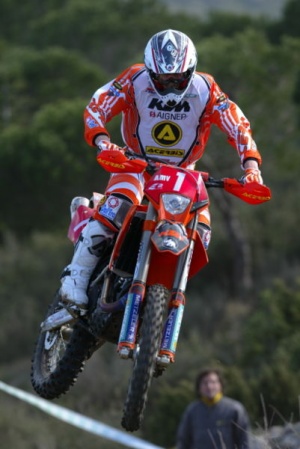
Main article World Enduro Championship
The World Enduro Championship (WEC) is run under the FIM and generally consists of around 8 or 9 2 day events, spread around the globe.
In 2006 Ivan Cervantes won the Enduro 1 class for Spain, Samuli Aro took the enduro 2 class for Finland while David Knight won Enduro 3 for Great Britain.
In the US, the American Motorcycle Association's (AMA) rules govern most regional sanctioning bodies and the Enduros that they sponsor. There is a somewhat popular variation on the rules called Brand-X, but that format is not accepted by the AMA and points earned in Brand-X Enduros do not count towards AMA points standings.
AMA National and Regional Enduro Events
The American Motorcycle Association is the primary sanctioning body for motorcycle races of all types in America. AMA series are often analogous to FIM series. In Europe, the FIM is the dominant sanctioning body for bikes and cars.
The East Coast Enduro Association, has multiple classes which are divided by bike type and rider demographic that allow a qualified rider to choose a class to compete in.
The following is a list of bike classes:
- Each Class (A, B, C) is divided in to sub-classes depending on machine type. Some examples include "C 4-stroke," "C-Veteran," "B 2-Stroke Light," "B 2-Stroke Heavy," etc... Generally speaking, there are rewards at both the event and season level for each sub-class (i.e., "I was the B 2-Stroke Light winner at this event...").
- Class AA - The most accomplished level of rider, same as "Class A,", but who competes for points as part of the AMA National Enduro Championship. For example, Mike Lafferty, who is the 7 time AMA National Champion, competes in the AA class.
- Class A - These are also the fastest riders, but they are not competing for points as part of the National Championship. Their awards are restricted to the AMA Region in which they compete. They are amateur participants, although they possess a skill level comparable to many of the AA riders.
- Class B - The is the second level of rider skill (one step up from the entry level C-class). Riders are "promoted" by the AMA when they have received a certain number of points (promotion points are different from the points that are awarded during a race; points during a race are bad, as the goal is to finish an event with as close to 0 points as possible, whereas title/promotion points are awarded at the end of each event depending on how well each rider performed - the dual use of the nomenclature "points" can often be confusing to outside observers, because the connotation of having points during an event is negative, whereas the connotation of having points relative to a rider's standing in a series is generally positive).
- Class C - This is the entry level where all new riders begin. All riders start off as C-Class riders and if they continue to participate in and finish events they will likely be promoted to B-class after 2 or 3 seasons. Exceptional riders will make the leap to B-Class after their first season because they will have accumulated the requisite points quickly enough.
Because of the variety of awards that are possible, riders are sometimes accused of sandbagging.
The Popularity of Enduro
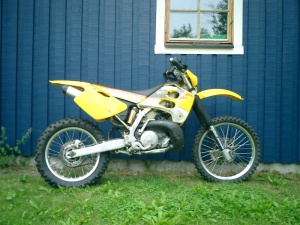
Enduro's popularity varies widely by continent, country, region, and even by event type. Some events are loosely categorized as Enduros even though they fall in to a category of off-road racing that is known correctly as rally racing. Rally racing is a form of off-road racing that generally follows wildly varying off-road terrain over very long distances for extended durations of time. Note that the European English and American English spellings of Rally vary, with the Europeans spelling it Rallye with an 'e' and the Americans omitting the 'e.' Even in foreign languages such as French (incidentally, the sanctioning body for many of the larges, most popular desert rallys is a French organization known as the TSO, organizers of many famous events such as the Dakar Rally, the Enduro du Touquet, and the Tour de France), the world Rally is used and is spelled Rallye. Rallys are sometimes called "Rally Raids," in the UK and parts of Western Europe.
Examples of such events are the Masters Rallye and the Pharaos Rally, but perhaps the most famous rally is the Dakar Rally, which was formerly known as the Paris-Dakar Rallye before the starting point and route started varying each year. One famous race that uses the name Enduro, but is not a timekeeping event, is the Enduro du Touquet, but even that event has recently changed its name to simple Le Touquet, perhaps to avoid confusion.
The distinction between Rallys and Enduros is an important one when gauging the popularity of the sport, as Rallys tend to attract fans numbering in the tens or even hundreds of thousands.
Enduros, on the other hand, are usually very difficult to observe as a spectator because of their usually rural locale and the fact that the course usually winds through wooded areas where grandstands are impossible to erect, where the vegetation and geological formations obscure visibility, and where simply getting to the race course is difficult in the first place.
Generally speaking, Enduros garner not much attention from outside of the Enduro community. Notable exceptions include the ISDE, but even that does not attain much media attention outside of the sport; nor it doesn't attract many in-person spectators for the reasons mentioned above.
For all of these reasons, Enduro remains a sport in obscurity from the public, and accordingly there is a limited amount of corporate interest in the sport outside of off-road motorcycle and related equipment manufacturers. As a result, there is little outside advertising for non-Enduro related products because there are no spectators on whom they hope their advertising will be ultimately effective. The result of this is that the vast majority of Enduro participants are amateurs, and there are very few professionals relative to the number of overall participants. A further effect is that very few professionals make a living that is comparable to professional athletes in other sports. Even other off-road racing series' athletes make a substantially greater living than Enduro's top riders. Very few Enduro professionals can make substantial living solely from their chosen sport and related sponsorships. There are exceptions to be sure, such as Mike Lafferty, but they are few and far between.
Often, very competitive Enduro riders will compete in similar non-Enduro events or in other Enduro series. A common occurrence is for top US riders to go to Europe to compete in the ISDE in order to get exposure and for the experience. Another frequent occurrence is for top Enduro riders to compete in rallys, since the requisite riding skills are very similar, and since the exposure is far greater (as is the potential for future factory or similar sponsorships).
Some of the famous riders listed below, such as John Deacon, were more famous for their Rally exploits than their Enduro exploits, whereas people like Mike Lafferty have yet to transpose their skills over a Rally.
Variations on Enduro
In addition to the Rallying, there are other off-road races that are very similar to Enduros but that vary in that they are not necessarily timekeeping events and in that they are often sanctioned by other bodies than the primary Enduro sanctioning bodies.
One example in the USA is the Grand National Cross Country, which more closely resembles Hare scrambles than Enduros, but is on a shorter course of perhaps a few miles/kilometers in length that is repeated for several laps. GNCC is famous for the high level of ATV (four-wheeled off-road vehicles) competition in addition to motorcycle competition.
Famous Riders
- Mika Ahola
- Samuli Aro (four-time World Enduro Champion)
- Dick Burleson
- Andy Caldecott
- John Deacon
- Jeff Fredette (25-time ISDT/E medalist) [1]
- David Fretigne
- David Knight (two-time World Enduro Champion)
- Mike Lafferty (multiple AMA National Enduro Championships)
- Fabrizio Meoni (Dakar Rally winner)
- Stefan Merriman (four-time World Enduro Champion)
- Richard Sainct (Dakar Rally winner)
- Juha Salminen (11-time World Enduro Champion)
- Petteri Silvan (five-time World Enduro Champion)
- Malcolm Smith
- Kari Tiainen (seven-time World Enduro Champion)
- Homero Díaz
- Perry Hodges
- Geraint Jones (10-time British Enduro Champion & Multiple ISDE medalist)
See also
External links
- Official FIM website (in English and French)
- Enduro News Daily reports on Enduro & offroad motorcycling
- American Motorcyclist Association (in American English)
- East Coast Enduro Association (one of the many American Enduro sanctioning bodies that conforms to AMA rules and represents several AMA Districts within the AMA's Northeastern Region; there are similar entities through the U.S.A.)
- World Enduro Championship
- Auto Cycle Union (British Governing Body)
- Enduros in Scotland (Main page for all events in Scotland)
- Motorcycling Australia (MA)- Australian Governing Body
